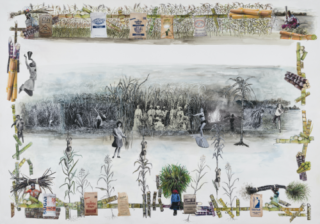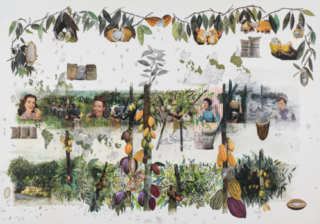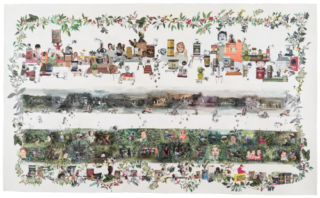
Paradossi dell’abbondanza #38 2020
drawings, collage, mixed media on paper
Private collection

Paradossi dell’abbondanza #39 2021
drawings, collage, mixed media on paper
Private collection

Paradossi dell’abbondanza #44 2021
drawings, collage, mixed media on paper
Commissioned for Rethiking Nature
Courtesy of the artist and Galleria Lia Rumma, Milan and Naples
Marzia Migliora’s research investigates the relationships between capitalism and agriculture, focussing in particular on how industrial agriculture and extractive practices over the last 100 years have affected family farming and agrarian labour in Italy. Her work condenses, through a variety of mediums, a critical reflection informed by a spectrum of research materials, from academic writing to popular culture, from field research to the artist’s personal experience of growing up in a family of farmers in northern Italy. Paradossi dell’Abbondanza is a series the artist initiated in 2015 as a long-term project to explore the transformations in the systems of production and consumption of food. Inspired by An Edible History of Humanity, a book written by British journalist Tom Standage that traces the history of agriculture from the Neolithic Revolution to the present day, the series of 46 collages to date investigates how the systems of labor and production of agricultural produces have transformed over time, and traces visually how racialized and exploitative systems are whitewashed by capitalism through marketing and popular cultural strategies.The works presented in ‘Rethinking Nature’ focus on three of the major everyday foods imported to Italy: coffee, sugar, and cocoa. Migliora creates visual landscapes that unveil the trajectory from the colonial plantation to domestic consumption, juxtaposing images of workers in the fields with portraits of white women enjoying coffee as a bourgeois status symbol. For the collages, the artist draws materials from a variety of sources, including her grandfather’s farming manuals, Tall-Tale Postcards from the United States’ Midwest, and 1960s product advertising, which are juxtaposed to unveil the fictional narratives surrounding food that were constructed across the twentieth century, which transformed harvests into products. The artist merges visual elements from different chronologies to illustrate how, across phases that include the Industrial Revolution, the Economic Boom, and the Green Revolution, capitalist farming has progressively eliminated traditional forms of tending to and caring for the land, drawing farmers into employing pesticides, patented seeds, and intensive forms of agriculture that depleted lands that had been cultivated for generations – an experience of loss of knowledge and nourishment that directly affected the artist’s family.
Artist’s statement
I spent my childhood in a house surrounded by crops and farming animals. I believe that rural life, the caring of the land and the determination that plants demonstrate have shaped my artistic vision. My family is just one case among countless victims of a system of industrialisation that has mistaken food for a commodity and the idea of development for a purely economic project. Today, a farmer sells a hundred kilos of corn for about the price of one pizza: this simple comparison shows a distortion of the methods, economies and values of a market whose current economic model does not protect family farming – which has become impractical – because it was designed for large-scale farms. As an artist, it is of primary importance for me to keep the reality of what surrounds us at the centre of my research; I believe my role is to give voice to uncomfortable situations. My works are often born out of annoyance, something that happens to us, a problem that I cannot materially solve, but on which I intend to activate reflections through my work.